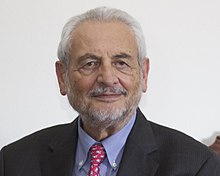Claudio Pellegrini
Claudio Pellegrini (* 1935 in Rome ) is an Italian - American physicist who deals with the physics of particle accelerators busy. He is particularly known for pioneering work on the use of the free electron laser as an X-ray source .
Pellegrini obtained his physics diploma in 1958 at the University of Rome, where he completed his habilitation in 1965 (Libera Docenza) . From 1958 to 1978 he was at the Italian particle accelerator center in Frascati and then until 1989 co-director at the accelerator physics center of the National Synchrotron Light Source of the Brookhaven National Laboratory .
In 1989 he became Professor of Physics at the University of California, Los Angeles (UCLA).
Pellegrini dealt theoretically with the physics of particle accelerators, especially instabilities and collective effects in particle beams of high intensity (in Frascati he discovered head-tail instabilities , head-tail instabilities with Bruno Touschek and Matthew Sands ) the interaction of particle beams with electromagnetic radiation and Plasmas. He has been working with free electron lasers (FEL) since the 1980s and proposed in 1992 to build a FEL at SLAC in self-amplified spontaneous emission (SASE) mode to generate sub-picosecond X-ray pulses, resulting in the Linac Coherent Light Source (LCLC), which is currently (2010) being built at SLAC. At UCLA's Neptune Laboratory, he was involved in experiments on accelerator concepts that are intended to open up possibilities for accelerators for very high energies - in the 100 TeV range ( Inverse FEL and Plasma Beat Wave Accelerators ).
In 1987 he became a Fellow of the American Physical Society . In 2001 he received the Robert R. Wilson Prize and in 2000 the Free Electron Laser Prize. In 2014 he was awarded the Enrico Fermi Prize and in 2017 he was elected to the National Academy of Sciences .
literature
- Andrew Sessler, Edmund Wilson Engines of creation , World Scientific 2007
Web links
References
- ↑ Ernest Courant , Pellegrini, W. Zakowicz High Energy Free Electron Laser Accelerator , Physical Review A, Volume 32, 1985, p. 2813. The concept goes back to Robert Brian Palmer 1972.
- ↑ Acceleration with a longitudinal plasma wave, generated by two laser beams whose beat frequency corresponds to the frequency of the plasma wave. The concept comes from T. Tajima and John M. Dawson .
| personal data | |
|---|---|
| SURNAME | Pellegrini, Claudio |
| BRIEF DESCRIPTION | Italian-American physicist |
| DATE OF BIRTH | 1935 |
| PLACE OF BIRTH | Rome |
